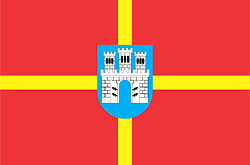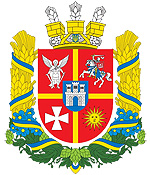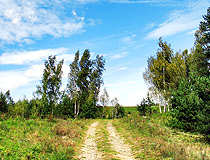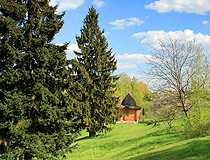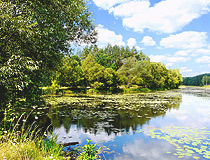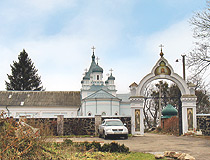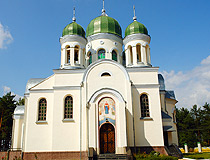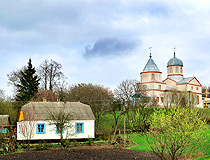History of Zhytomyr Oblast
Zhytomyr Oblast has a rich history. It played an important role in the Slavic culture in general and Ukrainian in particular. Primitive people already lived in the territory of the present Zhytomyr region about 100 thousand years ago during the Middle Paleolithic.
In the 5th-7th centuries AD, the territory of the region was inhabited by Early East Slavic tribes: the north - the Drevlians, the central part and the south - the Polans, who were engaged in agriculture and cattle breeding. The Drevlians were also engaged in hunting, beekeeping, jewelry manufacturing, and trade. In the 9th century, the first towns were founded that became centers of crafts and trade: Ovruch and Korosten.
In the 10th-12th centuries, the entire territory of the Zhytomyr region was part of Kievan Rus, then - the Vladimir-Volyn and Galicia-Volyn principalities. In the first half of the 13th century, along with other Slavic lands, this region was subjected to the Mongol invasion. In 1350-1360, the Lithuanians gained control of Eastern Volhynia.
In the 14th-16th centuries, most of the territory of the present Zhytomyr region was part of the Kiev Voivodeship of the Grand Duchy of Lithuania. After the Union of Lublin of 1569, Lithuania united with Poland into a single state - the Commonwealth. Since that time, Volhynia came under Polish control.
More historical facts…
After three partitions of Poland (1772, 1793, 1795), Volhynia, together with the Kyiv region and Podolia, became part of the Russian Empire. The territory of the region became parts of Volhynian and Kyiv governorates formed in 1797. In 1804, the town of Zhytomyr became the center of the Volhynian Governorate.
Since the 19th century, the development of the economy of the province was closely linked to the single market of the Russian Empire. The social division of labor was deepening, trade was developing, the urban population was growing. However, despite some development of production and trade, the Volhynian Governorate was one of the economically backward lands.
During the Civil War of 1918-1920, the entire territory of the region became a battlefield with multiple sides: the troops of the Ukrainian People’s Republic, “red”, “white”, and a lot of gangs who called themselves self-defense units.
In 1921, under the Treaty of Riga, the western part of the Volhynian region became part of Poland, while the eastern part remained in the Ukrainian SSR. In 1925, all the provinces of the Ukrainian SSR were abolished. In 1932, the first oblasts were formed. The present Zhytomyr Oblast was formed from the western districts of the Kyiv region on September 22, 1937. In 1939, the population of Zhytomyr Oblast was about 1,689,000 people.
From 1941 to 1944, during the Second World War, Zhytomyr Oblast was occupied by German troops. The level of destruction was very high, the local population for the most part died or was forcibly displaced to Germany. The region was liberated during the Zhytomyr-Berdychiv offensive operation in January 1944.
In Zhytomyr, about 40% of the housing stock was destroyed, as well as almost all enterprises, engineering communications, a railway station, a tram park, a power station, and the like. The population of the city reached the pre-war level only by the end of the 1950s. In 1959, the population of the region was about 1,605,000.
Zhytomyr Oblast is a region of forests, which cover about one third of its territory. In 1968, in order to protect this natural wealth, in the northern part of the Zhytomyr region, in the upper Ubort River, the Polissya Nature Reserve was created.
In 1989, the population of Zhytomyr oblast was about 1,545,000. Since then, the trend towards population decline has accelerated and to date, the population of this region compared with 1989 has decreased by more than 20%.
Beautiful nature of Zhytomyr Oblast
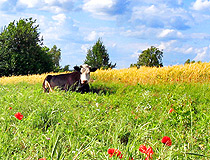
Summer in the Zhytomyr region
Author: Victor Galanin
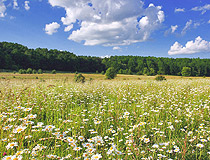
Camomile field in Zhytomyr Oblast
Author: Victor Galanin
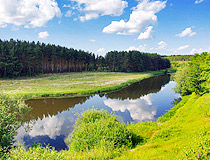
Small river in the Zhytomyr region
Author: Victor Galanin
Zhytomyr Oblast - Features
Zhytomyr Oblast is located in the central part of the East European Plain, in the north of the Right-Bank Ukraine. This region has a border with the Republic of Belarus 280 km long. The length of the Zhytomyr region from west to east is 170 km, from north to south - 230 km.
The climate is temperate continental with warm, humid summers and mild, cloudy winters. The average temperature in July is plus 18.5 degrees Celsius, in January - minus 5.5 degrees Celsius.
Due to its favorable geographical position and an extensive network of roads and railways, Zhytomyr Oblast has convenient transport connections with Kyiv, Lviv, Uzhhorod, Kharkiv, Odessa, Minsk, Moscow, St. Petersburg, as well as countries of Eastern and Central Europe. The distance from Zhytomyr to Kyiv by rail is 165 km, by highway - 131 km.
This is a developed industrial-agricultural region. But there are natural obstacles to large-scale farming - wetlands and adverse weather events (hail up to 6 days a year and heavy torrential rains).
The region has deposits of the following natural resources: brown coal, gray granite, labradorite, ilmenite, beryl, opal, topaz, marble, peat.
Major local industries: metallurgical, metalworking, machine-building, chemical, food (dairy, sugar, butter and cheese, malt), building materials (ceramic tiles), wood-chemical, porcelain, pulp and paper.
Agriculture: crop production (wheat, corn, buckwheat, flax, sugar beets, hops, rye, potatoes, oats, mustard, oil radish, paiza), livestock (meat and dairy).
People of dozens of nationalities live in the Zhytomyr region, most of the population nonetheless are Ukrainians. This region was always characterized by a large diaspora of Poles, but the number of Belarusians is relatively low, despite the fact that the region is located on the border with Belarus. Before the Second World War, there was also a large Jewish diaspora.
Many famous people were born in the Zhytomyr region: academician Sergey Korolev, poetess Lesya Ukrainka, writers Vladimir Korolenko, Joseph Konrad, Vsevolod Nestayko, poet academician Maxim Rylsky, Ukrainian pharmacist Viktor Trokhimchuk, scientist Ivan Ogienko, pianists Svyatoslav Richter, Naum Starkman, Nathan Perelman, opera singers Pavel Karmalyuk, Olga Mikitenko, Yevgeny Chervonyuk, classic of Ukrainian music Boris Lyatoshinsky, composers Yuliush Zarembsky, Alexander Stetsyuk, Sergey Zhukov, Ruslan Quinta, Anatoly Beloshitsky, Stanislav Olshevsky, Sergey Yarunsky, Vitaly Vyshinsky.
Some interesting facts about the Zhytomyr region:
- The Brusyliv District is the youngest district in Zhytomyr Oblast. It was formed in 1990 in connection with the resettlement of residents from the districts affected by the Chernobyl accident.
- The town of Korosten annually hosts the International Festival of Deruny (potato pancakes).
- In the 19th century, the town of Berdychiv was considered a smuggling center of Eastern Europe. In 1867, police discovered a grand maze of 130 underground passages and 78 secret depots under the town.
Attractions of the Zhytomyr Region
Tourists often go past Zhytomyr Oblast preferring the western cities and regions of Ukraine. However, this region has a lot of interesting places and attractions. Significant part of them is located in Zhytomyr, but here we mention some of them located in other places of the region.
Barefoot Carmelite Monastery (1634-1642) in Berdychiv - a magnificent architectural complex with defensive walls, towers, and a beautiful Baroque church.
Object “Skala” (“Rock”) (1936) in Korosten - the former secret underground command post, part of the so-called “The Stalin’s Line”. It was built on the basis of a system of natural and artificial caves in granite rock, on which the old Russian town of Iskorosten stood in the 8th-13th centuries. It is also known as “The Stalin’s Bunker”.
Museum of Lesia Ukrainka in Novohrad-Volynskyi (Sobornosti Street, 94) - a small house in which the future famous Ukrainian poetess was born in 1871.
Geological Reserve “Kaminne Selo” (“Stone Village”) near the village of Rudnya-Zamyslovytska. Huge boulders scattered in the middle of the forest between pines and oaks form “streets” on which there are “houses”, “church” and “school”. On one of the stones there are three indentations resembling the prints of human feet - the “footprints of God”.
Evelina Ganskaya Palace (Balzac Museum) in Verkhivnya - a beautiful Empire-style palace with antique motifs in the decor built in 1800. In 1847, the writer Honore de Balzac lived here.
Neo-Gothic Catholic Church of St. Clare (1912) in Horodkivka standing on the shore of a pond from afar can be mistaken for a small medieval castle. The architecture of this building, which is not typical for Central Ukraine, shows a close interweaving of Romanesque and Gothic styles, emphasized by a combination of wild stone and red brick.
Radomyshl Castle. The building of a water mill on the southern outskirts of Radomyshl was erected at the end of the 19th century. In 2011, at the initiative of the Bogomolets-Sheremetev family, the historical and cultural complex “Radomysl Castle” was opened in the restored building. Here you can also find the Museum of Ukrainian Home Icons with a unique collection of Polesie icons.
Island of Love - a romantic island on a pond in the center of the village of Staryi Solotvyn. A small wooden fisherman’s house surrounded by birches stands on it. The place looks very picturesque and attracts tourists and photographers.
Korostyshiv Quarry - a picturesque artificial lake formed on the site of a flooded granite quarry. The rocky shores of the lake up to 10 m high, covered with pines and birches, resemble Karelian landscapes. The vertical walls of the quarry with a pronounced relief attract climbers and extreme lovers.
Underwater Museum in Malyn - a museum created for experienced and novice divers at the bottom of the flooded quarry. At a depth of up to 15 meters, you can see various quarry objects and buildings, as well as other exhibits donated by various divers clubs.
On the territory of the Zhytomyr region there is number of preserved noble palaces. The most interesting ones include Tereshchenko Palace in Chervone, Tereshchenko Palace in Andrushivka, Orzhevsky Estate in Nova Chortoryya, Uvarova Palace in Turchynivka.


